Keystone species - Study guides, Class notes & Summaries
Looking for the best study guides, study notes and summaries about Keystone species? On this page you'll find 304 study documents about Keystone species.
Page 2 out of 304 results
Sort by
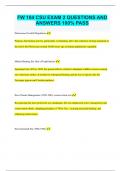
-
FW 104 CSU EXAM 2 QUESTIONS AND ANSWERS 100% PASS
- Exam (elaborations) • 15 pages • 2024
-
Available in package deal
-
- $9.99
- + learn more
FW 104 CSU EXAM 2 QUESTIONS AND ANSWERS 100% PASS Pleistocene Overkill Hypothesis Proposes that human activity, particularly overhunting, led to the extinction of large mammals at the end of the Pleistocene around 10,000 years ago as human populations expanded. Market Hunting Era (Era of Exploitation) Spanning from 1850 to 1899, this period reflects a belief in abundant wildlife resources among new American settlers. It resulted in widespread hunting and the loss of species like...
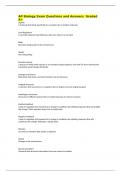
-
AP Biology Exam Questions and Answers Graded A+
- Exam (elaborations) • 26 pages • 2024
- Available in package deal
-
- $10.49
- + learn more
AP Biology Exam Questions and Answers Graded A+ Ligands A molecule that binds specifically to a receptor site of another molecule. Local Regulators A secreted molecule that influences cells near where it is secreted. Biotic Describes living factors in the environment. Abiotic Non-living things keystone species a species on which other species in an ecosystem largely depend, such that if it were removed the ecosystem would change drastically. analogous structures ...
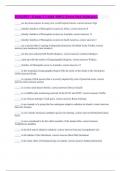
-
WIS2552 - Exam 2 || with 100% Error-free Solutions.
- Exam (elaborations) • 24 pages • 2024
-
Available in package deal
-
- $12.99
- + learn more
_____ are keystone species in many new world tropical forests. correct answers Figs _____ (family) families of Marsupials occur(s) in Africa. correct answers 0 _____ (family) families of Marsupials occur(s) in Australia. correct answers 15 _____ (family) families of Marsupials occur(s) in South America. correct answers 3 _____ are a species that is causing widespread destruction of habitat in the Tundra. correct answers (not muskoxen) (not reindeer) _____ are the most arboreal Old...
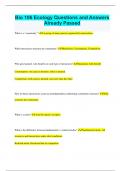
-
Bio 106 Ecology Questions and Answers Already Passed
- Exam (elaborations) • 7 pages • 2024
- Available in package deal
-
- $9.99
- + learn more
Bio 106 Ecology Questions and Answers Already Passed What is a "community"? A group of many species organized by interactions What interactions structure the community? Mutualism, Consumption, Competition Who gets harmed, who benefits in each type of interaction? Mutualism- both benefit Consumption- one species benefits, other is harmed Competition- both species harmed, one more than the other How do these interactions create an interdependence underlying community structure? ...
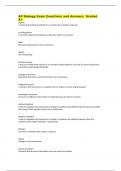
-
AP Biology Exam Questions and Answers Graded A+
- Exam (elaborations) • 26 pages • 2024
-
- $12.59
- + learn more
AP Biology Exam Questions and Answers Graded A+ Ligands A molecule that binds specifically to a receptor site of another molecule. Local Regulators A secreted molecule that influences cells near where it is secreted. Biotic Describes living factors in the environment. Abiotic Non-living things keystone species a species on which other species in an ecosystem largely depend, such that if it were removed the ecosystem would change drastically. analogous structures ...
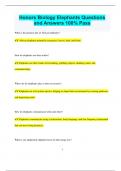
-
Honors Biology Elephants Questions and Answers 100% Pass
- Exam (elaborations) • 12 pages • 2024
- Available in package deal
-
- $9.99
- + learn more
Honors Biology Elephants Questions and Answers 100% Pass What is the primary diet of African elephants? African elephants primarily eat grasses, leaves, bark, and fruits. How do elephants use their trunks? Elephants use their trunks for breathing, grabbing objects, drinking water, and communicating. What role do elephants play in their ecosystem? Elephants act as keystone species, helping to shape their environment by creating pathways and dispersing seeds. How do elephant...
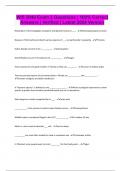
-
WIS 2040 Exam 2 Questions | 100% Correct Answers | Verified | Latest 2024 Version
- Exam (elaborations) • 8 pages • 2024
- Available in package deal
-
- $8.49
- + learn more
Restoration of the Everglades ecosystem will depend mostly on ___. - Reducing phosphorus levels Because of the bushmeat industry various species of ___ are particularly in jeopardy. - Primates Sulfur dioxide is found in the __________ - atmosphere Denitrification occurs in the absence of __________. - Oxygen Asian swamp eels are good invaders in Florida as they can ________. - Survive in shallow water The two principal species of salt marsh plants n Florida are ___________ and ___________. ...
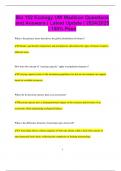
-
Bio 152 Ecology UW Madison Questions and Answers | Latest Update | 2024/2025 | 100% Pass
- Exam (elaborations) • 35 pages • 2024
-
- $10.53
- + learn more
Bio 152 Ecology UW Madison Questions and Answers | Latest Update | 2024/2025 | 100% Pass What is the primary factor that drives the global distribution of biomes? Climate, specifically temperature and precipitation, determines the types of biomes found in different areas. How does the concept of "carrying capacity" apply to population dynamics? Carrying capacity refers to the maximum population size that an environment can support based on available resources. What role do...

-
ASU BIO 182 Exam 3 Latest Update Graded A+
- Exam (elaborations) • 6 pages • 2024
- Available in package deal
-
- $9.99
- + learn more
ASU BIO 182 Exam 3 Latest Update Graded A+ biodiversity the variety of life in the world or in a particular habitat or ecosystem Cambrian explosion animal body plans evolved in a brief period carrying capacity the number of people, other living organisms, or crops that a region can support without environmental degradation Coevolution reciprocal evolution of two or more species. single species evolves in response to another group of species colonization Invasion of new region...
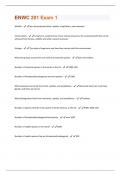
-
ENWC 201 Exam 1 All Possible Questions and Answers with complete solution
- Exam (elaborations) • 10 pages • 2024
- Available in package deal
-
- $9.69
- + learn more
he world, in the US - 5500, 965 Number of threatened/endangered mammal species - 1000 What separates mammals from birds, reptiles, and amphibians - Mammals have hair, mammary glands, and three ear bones. What distinguishes birds from mammals, reptiles, and amphibians - Feathers Number of species of birds in the world, in North America, in the US - 9900, 2000, 925 Number of threatened/endangered bird species - over 1000 Number of reptile species in the world - 8200 Number of reptile speci...

Study stress? For sellers on Stuvia, these are actually golden times. KA-CHING! Earn from your study resources too and start uploading now. Discover all about earning on Stuvia


